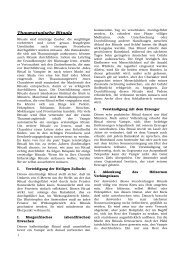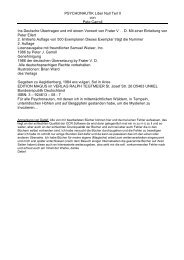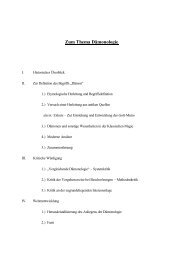CHAPTER 2 CHAPTER 3 CHAPTER 1 CHAPTER 2 CHAPTER 3 ...
CHAPTER 2 CHAPTER 3 CHAPTER 1 CHAPTER 2 CHAPTER 3 ...
CHAPTER 2 CHAPTER 3 CHAPTER 1 CHAPTER 2 CHAPTER 3 ...
Create successful ePaper yourself
Turn your PDF publications into a flip-book with our unique Google optimized e-Paper software.
<strong>CHAPTER</strong> 3 22<br />
The auroral and prominence forces are identical. Under the thick atmosphere of the Sun are hidden planetary<br />
bodies which are emanating aurora forces known on the Sun as prominence forces. The fact that there are<br />
planets under the Sun's photosphere is also evident from the fact that in atomic structure the electrons are<br />
balanced by an equal number of protons within the nucleus. This makes a balanced system.<br />
The prominence forces manifest in the atmosphere of the hidden, or inner planets, pass through their<br />
electro-magnetic field, then manifest once again in the atmosphere of the Sun. Then what about the so-called<br />
"hanging prominences" which "materialize" from nowhere in the upper atmosphere of the Sun? The solution<br />
to this baffling question can be found easily. When the auroral forces of the outer planets (Earth, Mars, etc.)<br />
pass through their vortex or electro-magnetic field, they are ultimately drawn into the great Sun body where<br />
they manifest. At this stage, astronomers observe the "hanging prominences" which "materialize" from<br />
nowhere!<br />
Another puzzle that has confronted astronomers, is that some sunspots appear to have polarity, and that some<br />
prominences are pulled mysteriously toward certain sunspots. Prominences and sunspots have already been<br />
shown to be manifestations of the auroral activity of the hidden or inner planets under the Sun's photosphere.<br />
There are twelve inner planets and twelve outer planets.<br />
Astronomers ask why sunspots arise at the more or less irregular intervals of eleven years, and why do first<br />
spots of a new series appear in high latitudes, and why is there a slow progression of the spots toward the solar<br />
equator as the sunspot cycle advances, and why is there a change in polarity of sunspots in alternate cycles?<br />
The answers to these questions will give an accurate and complete theory of sunspots, and the answers lie in<br />
the fact that the inner or hidden planets create these conditions by their periods of rotation and revolution.<br />
Heat and light are effects of the positive rays of the Sun. Heat is felt on the Earth because the Sun's positive<br />
rays intersect with its negative atmosphere and crust causing a friction or change in the quality of motion of<br />
the particles given off as heat radiation in consequence of this friction. The effect of the Sun's rays on the<br />
Earth's atmosphere is also responsible for the phenomenon of visible light which results from a different kind<br />
of motion of the particles.<br />
The eyes are only sensitive to positive light rays reflected from negative substance, thus light is an interaction<br />
of negative and positive forces. The Sun does not send us heat and light, although it is responsible for its<br />
manifestation on Earth; the Sun sends only positive lines of force which interact with the negative crust and<br />
atmosphere of the Earth to produce the phenomena of the electro-magnetic spectrum which includes heat and<br />
light.<br />
Science has explored the upper atmosphere of the Earth and found that sixty miles above the Earth artificial<br />
light is needed, and ninety miles above the Earth it is dark as "pitch". The higher we go the colder it gets, so<br />
we see even by logic that heat and light do not come from the Sun. Only lines of force come from the great<br />
sun body.<br />
Since distance and nearness to the Sun have nothing to do with whether a planet is "boiling" or "frigid", we<br />
can immediately see that all planets in our Solar System have nearly the same climate. The Earth does not<br />
enjoy perfect climate because it is unbalanced magnetically.<br />
What has been learned from space visitors about our Sun is not really anything new, but only a return to the<br />
ageless wisdom possessed by the Earth's most ancient races. These students of the long ago said that the true<br />
color of the Sun was blue, and it is interesting to note that the musical note of blue is Sol, a name for the Sun,<br />
itself!<br />
(2) The planet Earth (acting as an electron): As already stated, a comet is an early evolutionary form of a<br />
planet. But the behavior of a vortex in the formation of a particle such as the Earth has already been discussed.






